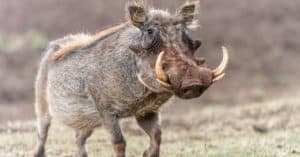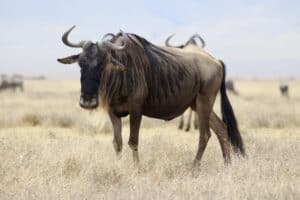Reindeer, also called caribou, are a large deer species that mainly live in the northern reaches of Greenland, Russia, North America, and other parts of Western Europe. Typically, wolves must work in packs to bring down these animals. That leaves us to wonder whether a single wolf could pull off such a feat. Discover the winner of a reindeer vs. wolf fight and learn which animal would stand the better chance of surviving this battle.
Comparing a Reindeer and a Wolf
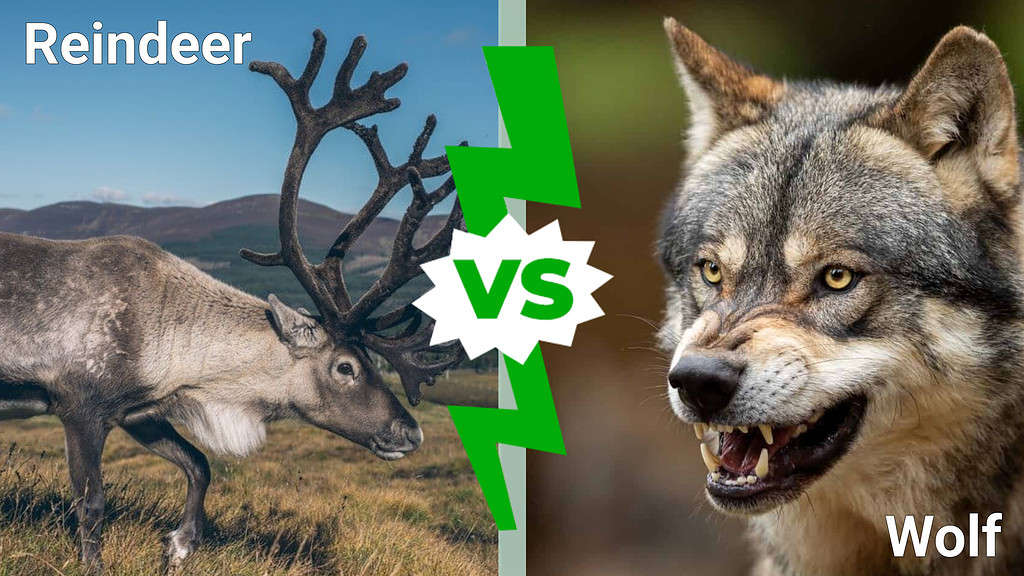
| Reindeer | Wolf | |
|---|---|---|
| Size | Weight: 130 to 700 pounds Length: 5 to 7 feet Height: 2.8 to 5 feet tall | Weight: 80 to 160 pounds Length: between 4 and 7 feet Height: from 2 to 3 feet |
| Speed | – Up to 50 mph | – 30 to 40 mph |
| Defenses | – Typically live in herds that offer some protection against attacks – Their large bodies make them tough to bring down – Reindeer have speed to get away from some trouble or initially make them hard to catch | – Wolves have thick fur to help lessen blows – Has the speed and agility to dodge enemies – Uses its strong senses to avoid troublesome situations |
| Offensive Capabilities | – Can deliver a powerful kick or stomp – Both sexes grow antlers that can severely injure attackers | – Has teeth measuring up to 2.5 inches long – Has bite force of 400 psi helps the wolf deal significant wounds – Fantastic stamina that helps them wear down their prey |
| Predatory Behavior | – None, they will flee before attempting to fight back | – They hunt prey using a cursorial method, chasing down prey in a group and wearing them down with repeated attacks from multiple directions – May attack from the rear and flanks to cause massive blood loss or go for the throat |
What Are 3 Key Differences Between a Reindeer and a Wolf?
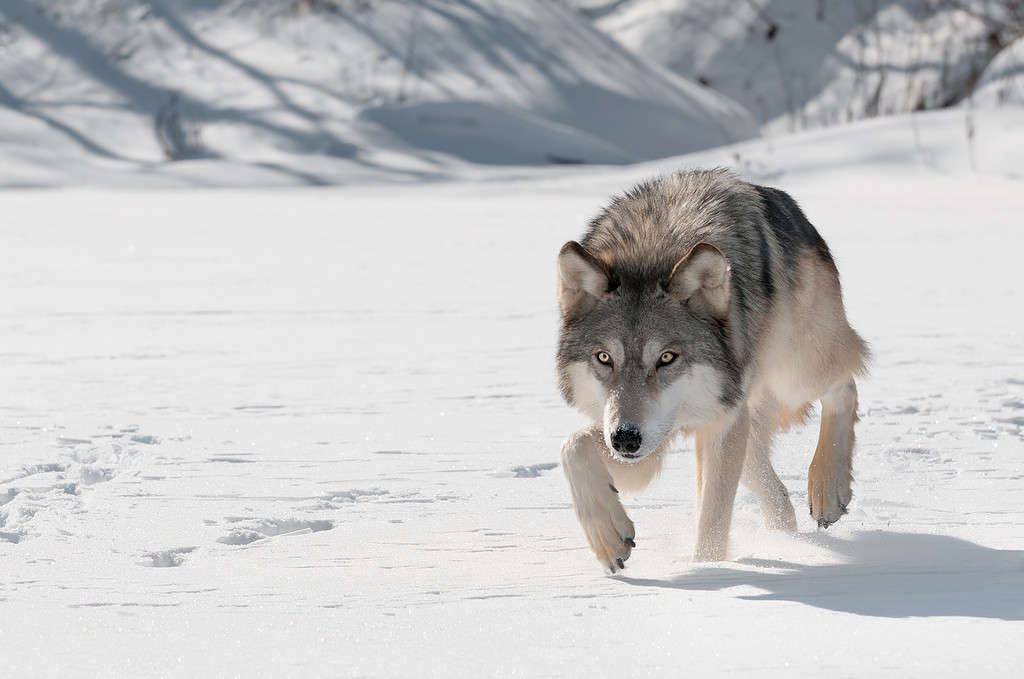
Wolves usually hunt in packs.
©Holly Kuchera/iStock via Getty Images
Reindeer and wolves differ greatly in terms of their size, feeding habits, and offensive abilities. On average, adult reindeer are much larger than wolves, weighing as much as 700 pounds and standing up to 5 feet tall while wolves weigh up to 160 pounds and grow 3 feet tall. Wolves are predators that often hunt their prey in groups, wearing down their prey with prolonged, repeated attacks. Meanwhile, reindeer are herbivores that may try to gore or kick anything that attacks them.
These differences are very important to the fight, but they’re not the only factors that matter.
What Are the Key Factors in a Fight Between a Reindeer and a Wolf?
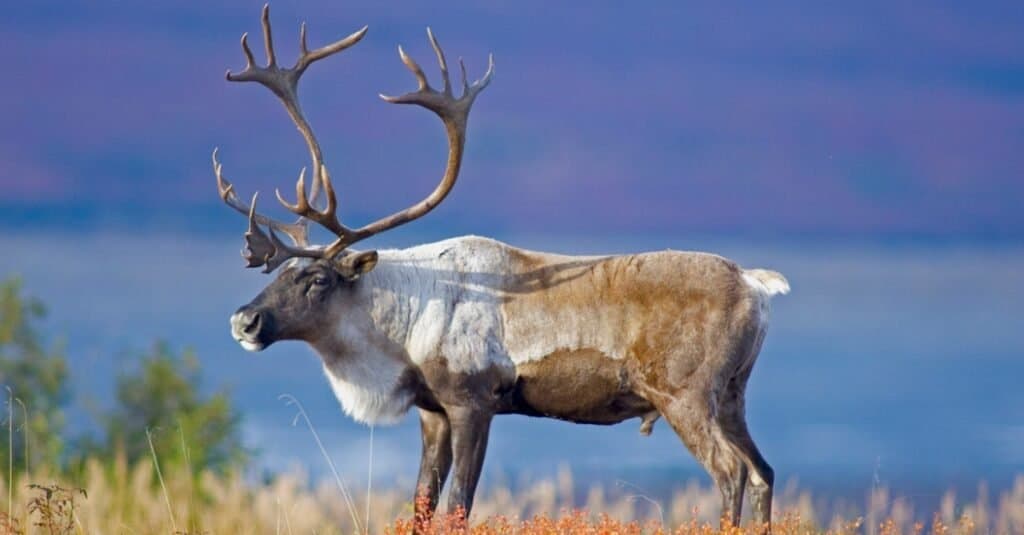
Reindeer can use their antlers to fend off attacks from predators.
©Jeff McGraw/Shutterstock.com
We must compare reindeer and wolves in several ways to understand the outcome of a one-on-one fight. In this case, this section will examine how the two animals compare in 5 key elements including size, speed, predation, defenses, and offenses. After comparing the two animals, we’ll learn which one has the advantage in various elements and then use that data for our final section, figuring out which animal would win in a one-on-one fight.
Reindeer vs. Wolf: Size
Gray wolves, the species we’re using as a touchstone for our wolf stats, typically weigh between 80 and 160 pounds, have a length of 4 to 7 feet from nose to tail, and stand between 2 and 3 feet tall. Meanwhile, reindeer can weigh between 130 and 700 pounds, grow 5 to 7 feet long, and stand up to 5 feet tall.
Reindeer are much larger than wolves, and they have the advantage in this facet of the fight.
Reindeer vs. Wolf: Speed
The average reindeer is quite speedy. They’re capable of running at speeds between 37 and 50 miles per hour. Wolves are not quite as fast, but they’re not exactly slow. They can run between 30 and 40 miles per hour, sometimes reaching upwards of 45 miles per hour over short distances. Also, wolves have great stamina, something they use to tire out their prey while attacking them.
Reindeer have the edge in speed in this battle.
Reindeer vs. Wolf: Defenses
Although both reindeer and wolves stay in packs, we are dispensing with them for the sake of this fight. Instead, we are focusing on individual defenses.
Wolves have thick fur that can provide a little protection against some blows and bites, but it’s nothing special. They rely on their great speed, agility, and endurance to keep themselves safe while hunting. Wolves also have fantastic senses to help them figure out when other potentially harmful animals are nearby, allowing them to get away before an adverse situation starts.
Reindeer are large, powerful creatures that are hard for lone animals to bring down due to their size. They are also quick when they’re fully mature and healthy, giving them the ability to escape the initial attack from some predators, like wolves. Typically, that is enough to save a reindeer as wolves attack the slower, weaker members of the herd. No such benefit exists in this case, though.
The reindeer’s great size is the most important form of protection in this battle, so the reindeer has a defensive advantage.
Reindeer vs. Wolf: Offensive Capabilities
Wolves have one weapon to use when hunting, their powerful bite. Wolves have a measured bite force of about 400 psi, but it could be as high as 1,000 psi. Their canine teeth can grow up to 2.5 inches long, allowing them to deeply puncture and tear the flesh of their prey.
Reindeer aren’t helpless, though. Both male and female reindeer grow antlers, giving them a powerful weapon against attackers. Reindeer can use them to gore their attackers while making it harder for would-be predators to attack their heads. They can also kick and stomp predators that get too close to them, but they’ll typically use their legs to run away first.
Wolves have the advantage in offensive capabilities.
Reindeer vs. Wolf: Predatory Behavior
Reindeer are herbivores, so they lack any hunting instincts. Meanwhile, wolves are cursorial hunters, chasing down their prey in packs and attacking them at the rear and flanks while running. Eventually, their prey can no longer flee, and the wolf will attack other vital areas, including the neck.
Wolves have the advantage in predatory behavior.
Who Would Win in a Fight Between a Reindeer and a Wolf?
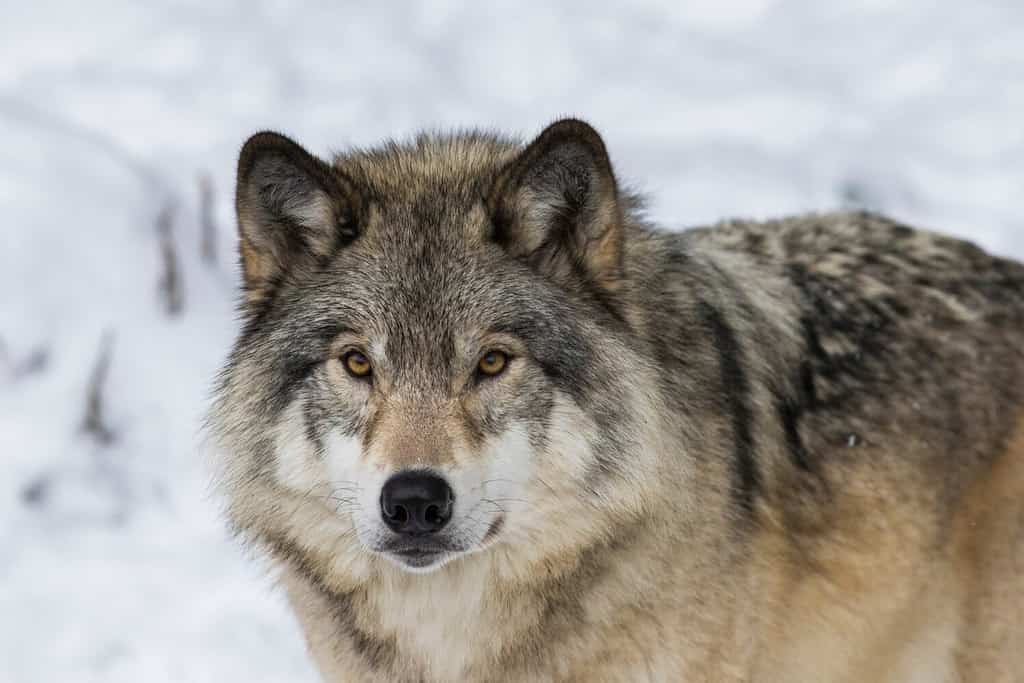
This fight is close, but the wolf has the edge.
©Mircea Costina/Shutterstock.com
A lone wolf has a better chance of winning a fight against a reindeer than a reindeer has of winning against a single wolf. While it’s rare for a wolf to risk hunting such a big creature on its own, a few accounts exist of a wolf attacking and killing reindeer on their own. At least one set of photographs shows a reindeer having killed a wolf but still dying in the process.
All that information aside, we must consider that a reindeer’s first instinct will be to flee from the predator even though that is exactly what the wolf wants the reindeer to do. If the wolf gets the reindeer on the run, it will continually attack, sap the reindeer’s energy, and eventually do enough damage that it will win. Even if the wolf doesn’t necessarily bring it down, it would win by sending the reindeer fleeing.
The fight becomes a lot harder to call if the reindeer decides to stand its ground and fight. The wolf will need to stay on the move and continue to attack again and again from different sides to keep the deer from landing a clean kick or goring the beast with its antlers. However, that is exactly the kind of attack wolves are capable of unleashing. Still, a single kick or a well-placed antler strike could kill or render the wolf helpless.
Given all the factors we’ve outlined here, the wolf gets the edge in a fight but not by a wide margin. The wolf would have to be rather skilled and desperate to take down a reindeer alone.
The photo featured at the top of this post is © pawopa3336/iStock via Getty Images
Thank you for reading! Have some feedback for us? Contact the AZ Animals editorial team.




